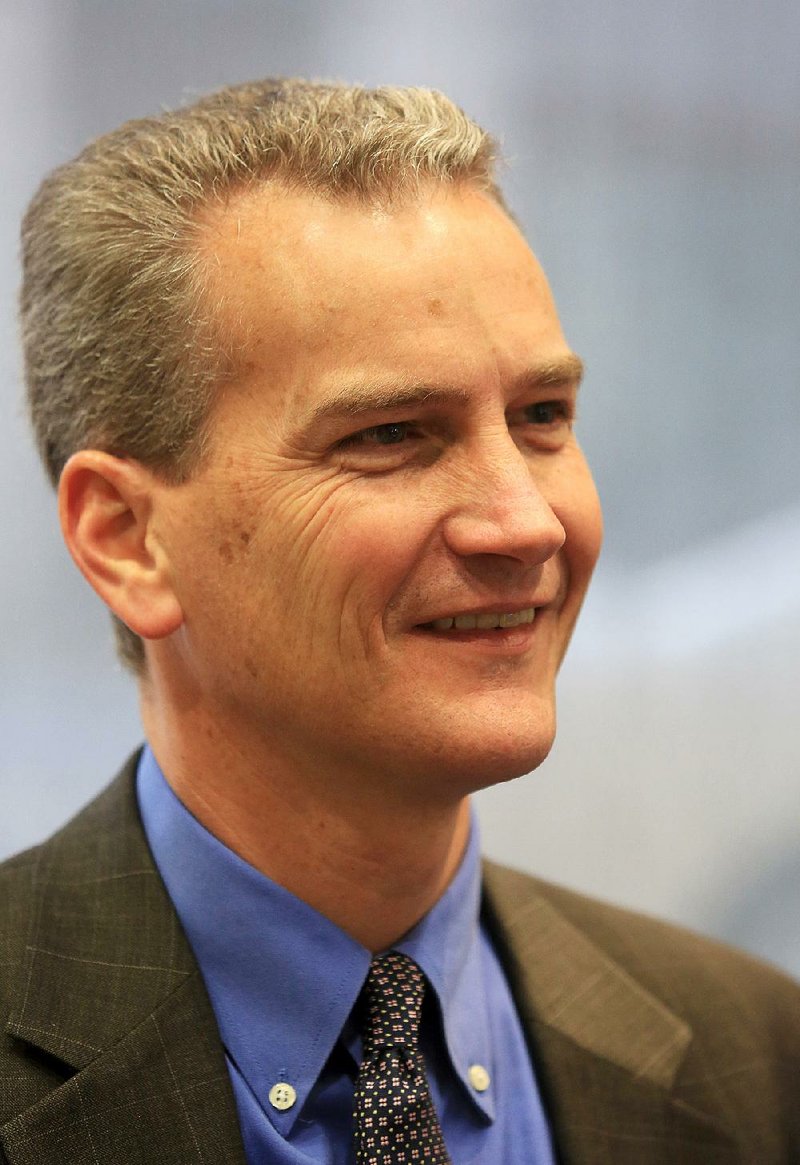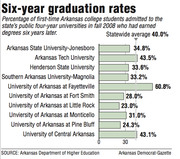The number of degree seekers at the state’s public universities remains steady, but those students are now graduating more quickly.
Statewide, the average percentage of students graduating in four years has risen from 21.5 percent of 14,305 first-time students entering a public university in fall 2007 to 25.7 percent of the 16,032 students entering in fall 2011, according to a recent report by the Arkansas Department of Higher Education.
The statewide average of students graduating in six years also has risen from 35 percent of the 13,847 firsttime students entering a public university in fall 2005 to 40 percent of the 15,193 students entering in fall 2009.
Meanwhile, the 10-year gradation rate has hovered around 40 percent for the past five years, department data show.
The report is telling for policymakers gauging the state’s economic health, officials have said. Having more graduates bolsters the education level of the workforce and helps attract industry.
“There’s really not much change if you look at the 10-year graduation rate over time, so we’re getting about the same number of people to a degree,” said Higher Education Department Director Brett Powell. “But since the six-year rate is increasing, it’s actually happening faster.”
The department changed the method of calculating the graduation rates last year in hopes of getting a more comprehensive picture of graduation rates.
Federal data — the way the higher-education institutions report — account for first-time students who are full time. But the state’s data went a step further, including first-time students, part-timers and students who enrolled in the spring semester.
The Higher Education Department used that information to calculate the 10-year rates for the first time to see whether students were reaching the desired outcome, Powell said.
The state has consistently fallen below the national average, which was 57 percent last year for first-time, full-time students who began seeking bachelor’s degrees at four-year public institutions in fall 2008 and earned degrees six years later, according to the National Center for Education Statistics of the U.S. Department of Education’s Institute of Education Sciences.
The center doesn’t complete statistics for the fall 2009 cohort until September.
Arkansas’ graduation rate is the fifth-lowest in the nation, according to the National Center for Higher Education Management Systems.
“It’s encouraging that we’ve made progress in terms of the four- and six-year graduation rates,” Gov. Asa Hutchinson said. “It’s good to have the trend moving in the right direction, but it also means you’ve got still over half of students who enter college [and] don’t finish.”
That rate has a ripple effect on the state’s economy, from property values to available jobs, state officials say.
“If you increase graduation rates, that’s going to be increasingly significant for the income per capita in Arkansas,” Hutchinson said. “It’s important economically and, obviously, for the lives of the graduates.”
The bottom line is to have students better prepared for the workforce, Powell said.
“We want them to be ready to go to work when they leave with whatever credential they have — a certificate, an associate’s degree, a bachelor’s degree, a graduate degree, whatever it is,” he said.
“And the better equipped the workforce is, the more likely we are to have more employers who are attracted to the state. It generates economic development. It’s just a cycle that hopefully, if you can get positive momentum, it continues to grow.”
The key, Hutchinson said, is to help students make the right decisions.
Of the state’s 10 public universities, three are above the state average for graduating within six years: the University of Arkansas at Fayetteville with 60.8 percent of 3,127 students, Arkansas Tech University with 43.5 percent of 1,825 students and the University of Central Arkansas with 43.1 percent of 2,253 students.
Eight of the the 10 public universities reported increases from one year to the next. The biggest jump was at Henderson State University, which rose from 24.7 percent of 924 students in 2013 to 33.6 percent of 753 students in 2014.
During the past year, Henderson’s leadership completed a strategic planning process, which emphasizes student success, Provost Steve Adkison said.
“The bottom line really here is that we’ve really refocused on what we’ve always done best, [and that] is to treat our students like they’re our own children,” he said. “We’re all about students here. We want them to be successful.”
The 3,625-student university is placing all of its student resources under one roof, called the Student Success Center. It’s also home to federally funded programs for disadvantaged students, he said.
The federal programs have shown successes that university officials are hoping to duplicate in the general student body, he said.
Among the four-year universities, the University of Arkansas at Little Rock had the lowest graduation rate. There, 23 percent of its 731 first-time students graduated in 2014 after six years, according to Higher Education Department data.
The measures don’t accurately reflect UALR’s student body, though, its Provost and Vice Chancellor Zulma Toro said.
“UALR is a metropolitan university that serves students who often attend part time who work and have family responsibilities,” she said. “These students often take much longer than six years to graduate and are not counted in this measure.
“They stop out, they attend multiple institutions simultaneously, and they often transfer to other institutions. They are without a doubt, however, a success story for themselves, their families, UALR, and the state of Arkansas, and we are proud to serve them,” she said.
The university has improved its rates through the years. In the spring of 2013, 21.8 percent of 949 first-time students graduated within six years, an increase from the 17.6 percent of the 720 the year before.
Toro has attributed the improvements to several strategies focused on student support, including the requirement that all freshmen complete a “first-year experience course that is designed to help them learn how to be successful.”
She has also cited initiatives, such as the university’s living-learning communities, which puts together in the same housing area students with the same academic goals.
UALR is testing a program
— similar to one that online retailer Amazon.com uses — that creates algorithms for students based on data from transcripts, courses and surveys, University of Arkansas System President Donald Bobbitt said.
At Amazon, a shopper can buy a movie and see the purchases of similar shoppers, such as music selections, he said.
“That’s the sort of technology that we’re trying to bring into the higher-ed landscape,” he said. “Our goal is to try to determine where problems might be before they develop.”
The program is designed to help faculty members find any students who may need help. For example, Bobbitt said, a chemistry student may not be succeeding in the class because of problems with mathematics. The program would help the professor identify the student and the student’s shortcomings for a targeted intervention, he said.
Bobbitt is hoping to roll out the program to other colleges and universities in the UA System, the state’s largest network of schools.
“We’re not satisfied with the way things are right now, and we’re going to work with the chancellors and the campus to make this priority over the couple of years,” he said.
“It’s important for the state that all of us succeed in getting to the finish line. The way that this works best is when the faculty are aware of the issues because they have the largest influence on the students.”
The University of Arkansas at Fayetteville had the highest graduation rate at 60.8 percent of 3,127 students, according to the Higher Education Department. The university — which reports its six-year graduation rate at 62.3 percent using the federal method — has set a goal to increase the rate to 70 percent by 2021.
“Our hope is we’re up and make positive improvement another point or two,” Provost Sharon Gaber said. “We’re doing things much like the plan suggests.”
Enrollment at the university’s intersessions — a 10-day mini-term typically held between semesters — has been up, and the university has offered more courses, Gaber said. Officials also are working to place online an advising system that allows students to see what courses they need or can take for their degree programs.
The state’s largest university also has created an Office of Graduation and Retention after a committee studied ways to improve its rate.
The University of Central Arkansas has also set out a goal to increase its graduation rates to 60 percent by 2022.
“We’ve been staying pretty steady,” UCA Provost Steve Runge said. “We haven’t made any big moves in either direction. I’m not sure we’ll make 60 percent in that timeline.”
But that’s not stopping Runge and other UCA officials from trying.
“It’s a good target and puts us in the ballpark of the other schools,” he said.
UCA officials are working to build a better support network for incoming students. This year, the 11,698-student university recorded its highest fall-to-spring retention rate at 88.5 percent, he said, adding that it was just one data point.
“What we’ve got to do is make that sustainable,” he said.
The Conway university is also one of 11 universities participating in a four-year study called the College Transition Collaborative, administered by Stanford University, the University of Texas and Indiana University. The study’s administrators are tailoring strategies to improve retention and graduation rates for each university.
“What they were able to do then is to look at where there are hurdles for students on our campus,” Runge said.
The intervention for UCA will begin this fall and will include an online exercise for incoming students during the course registration period. The online exercise is a series of questions with certain scenarios that may place students in situations where they need help, or on the opposite side of the spectrum. It would gauge how the students would proceed.
During the course of 20 years, the university has started a number of initiatives to help retention and graduation rates but has often scrapped the programs to try another thing.
“We’re going to implement these programs, and we’re going to keep doing it,” he said. “It’s disappointing on some levels. It takes a lot of time and money to start these things. [You] want to make sure you’re doing the right thing and keep [it] going long term.”
The university is assessing each of the programs as it goes along to see which are effective, he said. Staff members have created a Student Success and Retention Council and are developing an enrollment management plan.
“There’s no magic bullet. There’s not one thing we know we can use to help every one student,” Runge said. “[The 60 percent graduation rate] is a pretty lofty goal, but we’re going to do everything we can to get there.”


